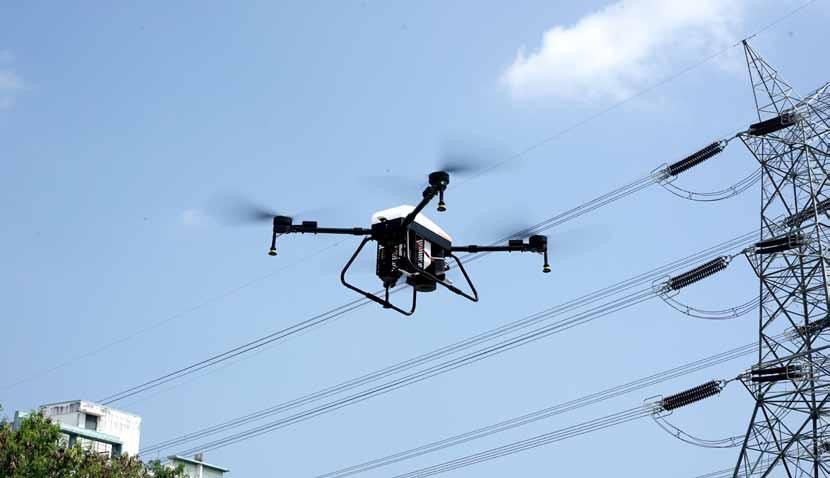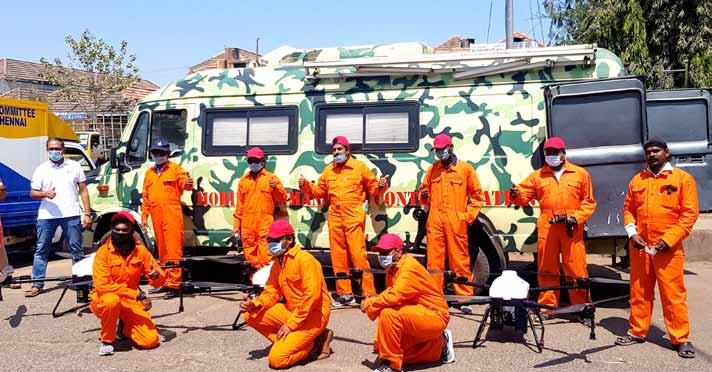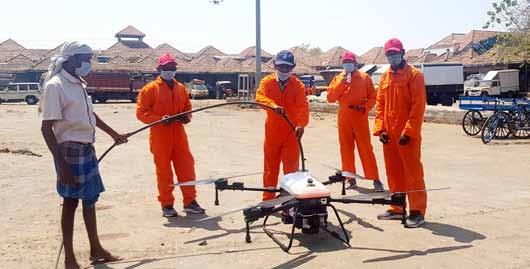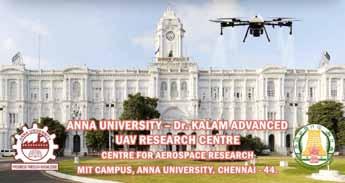
11 minute read
Drone: A lethal weapon against COVID-19
by Aeromag
To combat the dreaded pandemic, Tamil Nadu-based Anna University has developed the world’s first petrol-engine long endurance drone which can disinfect large areas. The drones created by the University have already been effectively deployed in Chennai City and based on this success, the University is planning to market the drone.

Advertisement
Countries around the world are attempting various means to contain the COVID-19 outbreak, which has been declared a pandemic by the World Health Organization (WHO) after it caused severe loss of lives on every continent. In India also, efforts are underway on a war-footing to fight the disease and Tamil Nadu-based Anna University has contributed to the cause by developing the world’s first petrol-engine long endurance drone which can disinfect large areas. In fact, the drones created by the University have already been effectively deployed in Chennai City. Based on the success, the University is also planning to market the drone for the good cause.
Caused by the coronavirus, officially referred to as the Severe Acute Respiratory Syndrome Coronavirus 2 (SARS-CoV-2), COVID-19 is highly infectious. The world is fighting against the disease by preventing its spread and controlling it to improve the chances of saving human lives. Scientists have suggested that there is a possibility of aerosol transmission of SARSCoV-2 similar to respiratory diseases such as tuberculosis, measles and chickenpox. In aerosol transmission, diseasecausing organisms are carried through air by aerodynamic forces or propelled through the air by force similar to an aircraft becoming airborne. The aerodynamic characteristics and transmission pathways of SARS-CoV-2 in aerosols are very difficult to identify in the real world due to the difficulties in sampling coronavirus and challenges in quantification at low concentration.
Airborne SARS-CoV-2
Drone to fight COVID-19: Anna University shows the way
was sampled and its aerosol deposition at 30 sites was studied in two designated hospitals and public areas in Wuhan, China where the world’s first cases were reported. Further, the SARSCoV-2 copy counts of aerosol samples were quantified using a robust droplet digital PCR-based detection method. It had been observed that the coronavirus or viral RNA concentration in aerosol is expressed in micro size. Hence there arose the need to spray the disinfectant using UAVs (unmanned aerial vehicles) as they covered the high altitudes of airborne virus.

The Chennai experience
While even developed countries were struggling to develop technologies to contain the COVID-19 pandemic, the Greater Chennai Corporation, Tamil Nadu began looking for appropriate and effective solutions for disinfectant spraying. Immediately responding to the crisis situation, Chennaibased Anna University (AU), as a first-of-its-kind initiative in the country, deployed its drones originally designed to spray pesticides for agricultural applications, to spray disinfecting chemicals

Dr.K.Senthil Kumar, Director, CASR,MIT with his team.
in public spaces after making suitable modifications.
Coronavirus is mainly transmitted via respiratory droplets and can also spread by touching contaminated surfaces. Disinfectant spray helps reduce these transmission mechanisms. For instance, residents of the narrow lanes of Mannady, North Chennai, are now used to the distant hum that grows louder every time an aerial vehicle is sighted. Hovering and moving at about

thirty feet above the road, drones spray a fine chemical mist. After a while, it is time for round two. This time, above the roofs of buildings, repeating the same exercise.
This is the drone army deployed by the Corporation of Chennai in its fight against coronavirus. In three weeks alone, five drones sprayed a fine mist of Sodium Hypochloride over an area of four crore square metres. Realizing the effectiveness

of their coverage, the Tamil Nadu government asked Anna University to supply 25 more drones to be used across other cities and towns in Tamil Nadu.
“While the ground-level fight was taking place with the help of sanitary workers and machine sprays, we felt the need to disinfect places with heavy human concentration, the narrow quarters which are usually left out of machine spray. Also, the containment zones posed a different challenge as we did not want to expose a large number of sanitary workers there on a regular basis,” explained Prakash, IAS, Commissioner, Chennai Corporation.
“As the drones cover a larger area they increase efficiency and the Corporation is planning to deploy more drones considering thier sheer effectiveness,” he added.
Anna University deployed its first fleet of four spraying drones in highly crowded/
inaccessible areas, Hot Spot Regions of Chennai for about 15 days and covered around 40 lakh square metres with 240 drone working hours, 1,200 successful take-offs and safe landings (for disinfectant refill), at 1/10th of the disinfectant consumption and 20 times faster area coverage, efficiency and consistency compared to manual spraying methods, thereby proving in real-time, the prowess of Anna University Drone Technology. This has been made possible thanks to the continued research efforts by Anna University over a period of 20 years, with financial assistance from Government of Tamil Nadu under various schemes such as Tamil Nadu Innovation Initiative Scheme (TANII) etc. and also support from its various MoU partners.
This contribution of Anna University not only helped the government in effectively responding to a Humanitarian Assistance and Disaster Response (HADR) situation but also in alleviating the fears of the public who were in panic and distress.
The drone deployed to combat COVID-19 is Anna University’s latest invention and another world’s first product. Having international standards, the drone carries payload of 16 litres of

disinfectant, flies on petrol and is capable of covering six times more area than battery-operated drones. It also has the lowest operational costs. Moreover, as a product made in India, support is just a phone call away, unlike imported drones.
In the long term, such deployment of drones by

Anna University can provide lessons for how public and private health systems can incorporate drone technology into their planning to mitigate future pandemics.
To ensure the efficiency and safety of aerial disinfection operations, IISC, Bangalore has published an advisory document on drone-based disinfectant spraying missions to contain COVID-19 outbreak by aerial disinfection, providing the necessary operational guidance and technical specifications and to make sure that all efforts were conducted in a safe and scientific manner.
More uses of drones
Apart from aerial spraying and disinfection, the drones can also be an effective tool in responding to COVID-19, in the following areas:
Transport of medical
samples: Delivering medical samples by drone from remote locations as far as 20 km to approved testing labs can significantly reduce unnecessary human contact throughout the transport cycle. It can also speed feedback for critical tests needed by patients and medical workers.
The aerial transport will significantly confine the flow of people, avoid unnecessary physical contact and prevent secondary transmission during this crisis of life and death.
Delivery of consumer
goods: Drone delivery of consumer items can ensure that people have access to food and other goods and make it easier for citizens to keep to recommendations limiting human contact. In just a few days, several drone delivery corridors can be put in place enabling contactless delivery and replacing unnecessary drives.
Crowd monitoring and public announcements:
Drones are a highly-effective medium for disseminating the targeted, customized public announcement message to the public as compared to phone or television broadcast. It is also effective for public surveillance to ensure effective lockdown.
COVID-19 drone lessons
The coronavirus outbreak has led to significant experimentation with many emerging technologies, including drones.
Drones need to be integrated into planned health responses. The results from coronavirus response efforts should be able to preplan how drones will be used during disease outbreaks and make appropriate investments rather than relying on ad hoc experimentation. As the world continues to tackle this crisis, these lessons can reshape how we protect and care for people during health emergencies. Realizing the impact of these drones and the efficiency and competency of the drones, the Tamil Nadu government has been piloting ways to incorporate more drones into their response to Coronavirus and sanctioned an amount of Rs. 5 crore for 25 more disinfectant spraying drones.
These experiments of Government of Tamil Nadu serve as a model for other Indian states looking to respond to the current health crisis on requirements towards provision of drone-based solutions to combat COVID-19 on turnkey/supply/service basis. According to Anna University, once the COVID-19 pandemic is controlled, the same drones will be useful and effective for deployment in situations like, spraying for mosquito control, pest/ locust control in agriculture, integration with firefighting vehicles, disaster response etc.
Prof M K Surappa
Vice Chancellor Anna University
Anna University has been a premier Institution in India with 225 years history of contributing in the field of Engineering and Technology. The university is one amongst the Top 10 Universities of the country as per the Ministry of Human Resource Development National Institutional Ranking Framework(NIRF) 2019 under the able leadership of its Vice Chancellor Prof M.K.Surappa.
Centre for Aerospace Research (CASR) located in the Madras Institute of Technology (MIT) Campus of Anna University is one of the constituent Centres of Anna University .
CASR is Spearheading a programme on Design and Development of UAV for societal applications funded by the Tamil Nadu Innovation Initiatives Scheme under the State Planning Commission. The Centre has already designed, developed and manufactured five categories of UAVs viz. (a) Multirotor UAV – Electric and Gasoline Type (b) Fixed wing UAV – Electric and Gasoline type (c) Tethered UAV (d) Vertical Take-off and Horizontal Transition (VTHT) UAV and (e) Helicopter UAV.
The Multirotor UAV developed at CASR, with its most stable design, became the only Indian UAV to have dominated the alien skies competing against 153 participating international teams, during May 2012 technology demonstration at Fort Stewart Military base organized by DARPA, Department of Defence, USA and the UAV Medical Express Challenge organized at Australia by Queensland University, Australia during September 2018.
The team has further achieved various laurels including Dr. APJ Abdul Kalam award 2018 of the Government of Tamil Nadu for contribution in the fields of Development of Science, Humanities and Welfare of the student, World record for Long endurance (duration record) for a Multicopter UAV under Federation Aeronautique Internationale (FAI), best flying team award during Drone Olympics, Aero India, 2019, India Geospatial Application Excellence Award for UAV based mapping -Volume calculation and modeling of minor and major minerals in the state of Tamil Nadu etc.,
During 2020, Anna university and its start up “Dhaksha Unmanned Systems” became the team to be shortlisted after the Final Fly Off event of the Mehar Baba Challenge aimed at design and development of collaborative UAVs equipped with appropriate software (e.g. Artificial Intelligence, Swarm intelligence, etc.), and hardware (e.g. multiple sensors, high payload capacity) for HADR operations, organized by Indian Air Force.
From a military innovation, to a technology that’s transforming civilian and military arena, the use of drones has rapidly changed over the past years — thereby presenting limitless opportunities in a way automobile and IT industries transformed India. In this Anna University drones contribution towards various civilian and military applications for the larger benefit of the nation and the mankind has been enormous, thereby making India being looked upon by the world for drone technology business opportunities cites Prof M K Surappa, Vice Chancellor, Anna University.
No of take-off per day (8 hrs shift )
Area covered per day in Sq.Mtr
Disinfectant tank capacity
Charging of Battery (or) Refueling Limitations of Battery-operated Electric Drones
10 - 12
50,000 – 60,000
10 Litres
Every 5 minutes Dhaksha’s AgriGator Drones
40 - 50
200,000 – 250,000
16 Litres
Fuel filling once every hour
Life of battery
Replacement cost
Generator & Battery Spares 100-120 charging cycles
Min Rs. 60,000 for batteries to be Imported.
Required additionally No batteries required
Max Rs. 5,000 Engine maintenance cost for every 50 hrs of usage
Not required
Other reasons why Dhaksha’s Petrol-engine Drones are better than Electric Drone
Serviceability: Electric drones are imported from China. Customer service is a big struggle. Even critical spares like batteries are not easily available and are very expensive. Dhaksha drones are well-supported in coordination with Anna University and spares are easily available at lower costs. Field operations: Electric drones need 2 battery chargers and 1 generator to be carried to all field operations for battery
Technical Specifications of Dhaksha AgriGator Drones
recharge. It is a logistical nightmare to handle and needs extra manpower. With Dhaksha drones, you just need petrol to operate that can be locally purchased. Environmental Impact: In Electric drones, after 100 to 120 charge cycles, batteries need to be discarded. This causes serious environmental impact and additional efforts for safe disposal. Dhaksha drones are environment friendly. No batteries to dispose-off.


Drone type: Dhaksha AgriGator Drone Disinfectant tank capacity: 16 litres Petrol tank capacity: 3.5 litres (Speed petrol) Flight speed for disinfectant spray: 3 to 4 metres per sec (11 to 14 kmph) Nozzle type: 4 numbers of Ultra low-volume atomizer type per drone Petrol consumption: 28 litres for 8 hours of operation with minimum payload Environment-friendly when compared to battery-operated drones
Contact for Inquiries
Dr. K. Senthil Kumar,Professor & Director – CASR, Anna University Mobile : +91- 9444102773 email : ksk.mit@gmail.com










